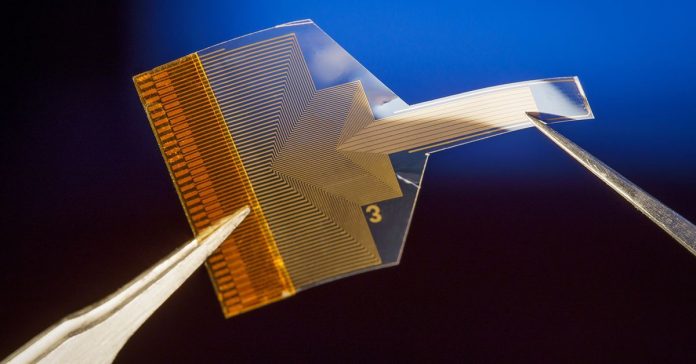Researchers have developed a neural implant that sits on the brain surface while providing neural activity information deep within
The implant, a thin, transparent, and flexible polymer strip implanted with graphene electrodes, promises to provide high-resolution data on deep neural activity while sitting on the brain’s surface.
Creating a brain-computer interface (BCI)
Researchers at the University of California San Diego have developed this cutting-edge technology, detailed in a recent publication in Nature Nanotechnology; this could be the first step towards creating a minimally invasive brain-computer interface (BCI).
Led by Professor Duygu Kuzum, the team behind this innovation aims to overcome the limitations of existing neural implant technologies.
“We are expanding the spatial reach of neural recordings with this technology,” explains Professor Kuzum from UC San Diego’s Jacobs School of Engineering. “Even though our implant resides on the brain’s surface, its design goes beyond the limits of physical sensing in that it can infer neural activity from deeper layers.”
What makes this different to traditional neural implants
Traditional neural implants face challenges in capturing information beyond the brain’s outer layers or causing inflammation and scarring. However, the UC San Diego implant combines surface displays’ advantages with penetrating electrodes.
The implant’s design incorporates a high-density display of tiny, circular graphene electrodes connected to a circuit board through micrometres-thin graphene wires.
Offering a clear view
Tested on transgenic mice, the implant successfully recorded both electrical and calcium activity simultaneously, providing insights into neural processes at various depths within the brain.
“The neural network model is trained to learn the relationship between the surface electrical recordings and the calcium ion activity of the neurons at depth,” adds Kuzum. “Once it learns that relationship, we can use the model to predict the depth activity from the surface.”
Part of the implant’s success is its transparency and high electrode density, combined with machine learning methods. Unlike traditional metal electrodes that block the view of neurons during imaging experiments, graphene electrodes offer a clear field of view, enabling simultaneous electrical recordings and optical imaging.
The researchers developed a unique fabrication technique involving double-layer graphene wires with nitric acid. This approach mitigates defects and impedance issues, resulting in fully functional, transparent electrodes.
Despite challenges in shrinking graphene electrodes without compromising electron flow, the team utilised microfabrication techniques to deposit platinum nanoparticles onto the electrodes, enhancing electron flow while maintaining transparency.
Continued research
The next research phase will involve testing the technology in different animal models, with the eventual goal of human translation. Professor Kuzum emphasises the technology’s potential for advancing fundamental neuroscience research and plans to share it with U.S. and European labs.
Various organisations funded this research, including the Office of Naval Research, the National Science Foundation, and the National Institutes of Health.
The team’s efforts are set to accelerate our understanding of the human brain, promising new insights into neurological disorders and brain function.














